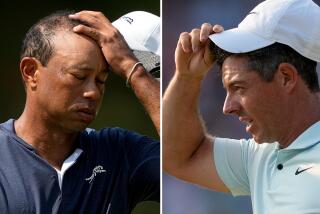Black Course Leaves Faces Red
- Share via
FARMINGDALE, N.Y. — On opening day at the U.S. Open, Bethpage Black rolled out the green carpet and welcomed the best golfers in the world to take their best shot. The big old softy. It had rained overnight and the course couldn’t have been more friendly if it had rolled over on its back and invited everyone to scratch its belly.
Instead of rock-hard greens, there would be fluffy pillows waiting to welcome golf balls. These guys were going to tear the place up Thursday. There would be more birdies out there on the course than buses in the shuttle lines, and as everyone here knows, there are zillions of those. The players were going to wrap the place in a pretty ribbon and call it Bethpage Pink.
That was the plan anyway.
Chances are, if there had been a day to lay waste to Bethpage Black, the scourge of the U.S. Open, the toughest layout since they invented misery, this would be that day.
Nothing of the sort happened. In fact, it wasn’t even a fair fight. On the first day of the 102nd U.S. Open, the golf course won, which is sort of what everyone was predicting when it was hot and humid and the greens were harder than the hoods of the courtesy cars in the players’ parking lot.
The fact that Bethpage Black stuck it to the players even when it was supposed to play easier cannot be a good sign for anyone who shows up for work today with his sticks.
Of course, the people who want the course to play tough, the U.S. Golf Assn. folks, are very pleased. The only thing that stops them from growing rough as high as the grandstands is the fact that you wouldn’t be able to see the players on television.
The last major championship to play so tough was the 1999 British Open at Carnoustie, Scotland, where there was enough hay to make a farm jealous, and it was all only a foot or so from the fairway.
Maybe that’s why it was so refreshing Thursday to see Jean Van de Velde doing well for a while, until Bethpage Black caught up to him. Remember it was Van de Velde who lost a three-shot lead on the last hole at Carnoustie, but not before charming everyone he met. The pro at Euro Disney, Van de Velde was asked what he had to do to keep his job and he explained that his duties included testing all the rides and having his picture taken with Minnie and Goofy.
It must help to have a sense of humor when your heart is getting run through a juicer.
Hale Irwin is a three-time U.S. Open champion and he shot an 82. Asked about his round, Irwin couldn’t remember it, but he said his faulty memory is entirely permissible because it falls under the category of a senior moment.
There were bogeys. There were double bogeys. There were triple bogeys. Players were trying to bogey for the cycle. No, that’s not right. They weren’t trying to, but it was happening without their permission.
This is what happens because of U.S. Open conditions, remember. Bunkers bigger than the Mojave Desert. Enough tall grass to feed a circus. A course so huge it needs three zip codes. Fairways so narrow you can’t walk down them unless you suck in your breath.
Davis Love III had six threes on the front side and shot 39 on the back. Wayne Grady had three sixes on the front and seven fives on the back, which would have been better if he had been playing cards. Woody Austin had three bogeys, a double bogey and a triple bogey--all on the last nine holes. There were other similar horror tales, too numerous to mention.
The sky was a grainy gray and gloomy, which accurately reflected the mood of most of the players after their experience at Bethpage Black. Only six of the 156 who started the day managed to shoot under par, with Tiger Woods leading the way with a 67. While this should not be considered a surprise, it can’t be encouraging news to everyone else trying to head him off from another major title.
Their hope was that Tiger would prove to be vulnerable here because the fairways are so narrow and the penalties so severe. Only three more rounds of hope remain. Woods didn’t hit every fairway and he didn’t make every putt, but a three-under score looks a lot better than that considering that very few did very little when they had the chance.
Woods started his round at No. 10, with two of the first three holes he played the longest par-fours in the history of the U.S. Open. He said it was the most difficult start he had ever experienced in a major, but he still managed to par the first three. And by the time Woods was done, he counted eight one-putt greens and said it was his best putting performance since, well, since he won the Masters.
However, Bethpage Black is not supposed to be as good to Tiger as Augusta National is ... or to anyone else, for that matter. It is basically rude to everyone. Yet we might not see the worst of its manners, because rain is in the forecast and that is likely to keep Bethpage Black from eliminating virtually everyone in the field by nightfall.
Woods was justifiably happy with his 67, but Colin Montgomerie was ecstatic with his 75, the way things were going. It’s not easy out there. The USGA officials like to say that par is a good score at the U.S. Open. They’re wrong. At this place, par is a great score.
More to Read
Go beyond the scoreboard
Get the latest on L.A.'s teams in the daily Sports Report newsletter.
You may occasionally receive promotional content from the Los Angeles Times.










